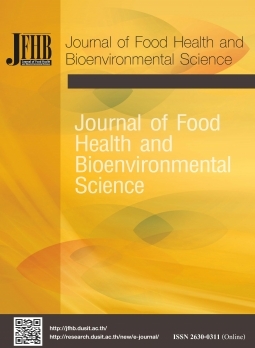The Effect of Cooking Process and Shelf Life Evaluation of Retort Pouch Packed a Tradition Meat Curry “Kaoyuk”
Keywords:
Kaoyuk, Retort Pouch, Traditional Meat Curry, Trang, ThailandAbstract
Kaoyuk is a traditional meat curry of Trang province, Thailand. It is prepared as a standard recipe. A retort pouch is used because it is a convenient thermal process in which the texture and flavor should be maintained in something close to the original condition. The purpose of the research is to were investigate the effect of the pre-cooking time of Kaoyuk and the change in quality of retorted Kaoyuk after 12 months storage. The effect of the pre-cooking time of meat at 0, 60 and 120 min before retorted process were studied and the texture analyzed and a sensory evaluation undertaken. The result found that the pre-cooking time at 60 min provided the tenderest meat, the retorted Kaoyuk was softened and also more retained the sensory qualities of the original. The 60 min of pre-cooked Kaoyuk were packed in retort pouch with thermal process on F0=11 min (118°C) and stored at room temperature (25±5°C) for 12 months. Physical properties, chemical properties, microbial properties and sensory evaluation were conducted every 3 months. Meanwhile, there was a significant decrease of pH from 5.9 to 5.46 and cutting force required was also was decreased from 8116 g force to 6320 g force whereas color L* a* b* values increased. The Free Fatty Acid value (FFA) was increased from 0.54 to 0.97 % of oleic acid and Thiobarbituric acid values (TBA) was increased from 0.64 to 1.07 mg of MDA/kg meat but no significant (P>0.05) growth of microbial and the sensory evaluation conducted from 10 trained panelists were accepted. The result showed that the retorted Kaoyuk can be store at room temperature for 12 months whilst maintaining acceptable safety and customer satisfaction levels.
References
Al-Baali, A.A., & Farid, M. (2006). Sterilization of food in retort pouches. New York: Springer Science, Business Media.
AMSA. (2015). Research guidelines for cookery, sensory evaluation, and instrumental tenderness measurements of meat. Chicago, IL: American Meat Science Association.
AOAC. (1995). Official methods of analysis. Washington DC: AOAC International.
AOAC. (2000). Official Method 940.28 Fatty Acid (Free) in Crude and Refined Oils.Washington DC: AOAC International.
BAM. (2001). Bacteriological Analytical Manual (BAM) online. Retrieved from https://www.fda.gov/food/laboratory-methods-food/microbiologicalmethods-bacteriological-analytical-manual-bam.
Bindu, J., Ravishankar, C., & Srinivasa Gopal, T. (2007). Shelf life evaluation of a ready-to-eat black clam (Villorita cyprinoides) product in indigenous retorted pouches. Food Engineering, 78, 995-1000.
Devadason, I.P, Anjaneyulu, A.S.R., Mendirtta, S.K., & Murthy, T.R.K. (2014). Quality and shelf life of buffalo meat blocks processed in retort pouches. Journal of Food Science and Technology, 51(12) 3991-3997.
Egan, H., Kirk, R., & Sawyer, R. (1981). Pearson's chemical analysis of food. Edinburgh, UK: Churchill Livingstone.
Gokhale, S.V., & Lele, S.S. (2014). Retort Process Modeling for Indian Traditional Foods. Journal of Food Science and Technology, 51(11), 3134-3143.
Hedruck, H.B., Aberle, E.D., Forrest, J.C., Judge, M.D., & Merkel, R.A. (1994). Principles of meat science (3rd ed.). USA: Kendal Hunt Publishing Company.
Jang, D.H., & Lee, K.T. (2012). Quality Changes of ready-toeat ginseng chicken porridge during storage at 25°C. Meat Science, 92, 469-473.
Jin, S., Kim, I., & Hah, K. (2002). Changes of pH: Drip loss and microbes for vacuum packaged exportation pork during cold storage. Korean Journal for Food Science of Animal Resource, 22(3), 201-205.
Kaban, G. (2013). Sucuk and pastırma: Microbiological changes and formation of volatile compounds. Meat Science, 95(4), 912-918.
Liu, D., Tsau, R., Lin, Y., Jan, S., & Tan, F. (2009). Effect of various levels of rosemary or Chinese mahogany on the quality of fresh chicken sausage during refrigerated storage. Food Chemistry, 117(1) 106-113.
Rajan, S., Kullkarni, V.V., & Chandirasekaran, V. (2014). Preparation and storage stability of retort processed Chettinad Chicken. Journal of Food Science, 51(1)173-177.
Shah, A.M., Bosco, J.S., Mir, A.S., & Sunooj, V.K. (2017). Evaluation of shelf life of retort pouch packaged Rogan josh, a traditional meat curry of Kashmir, India. Food Packaging and Shelf Life, 12,76-82.
Tayeh, N., Ayukhen, A., & Louhasakul, Y. (2019). Property changes of the traditional beef curry product “GulaiBesar” packed in retort pouch during storaging. Journal of Food Health and Bioenvironmental Science, 12(2), 28-34.
Tornberg, E. (2005). Effects of heat on meat proteins – Implications on structure. Meat Science, 70(3), 493-508.
Downloads
Published
How to Cite
Issue
Section
License

This work is licensed under a Creative Commons Attribution-NonCommercial-NoDerivatives 4.0 International License.








